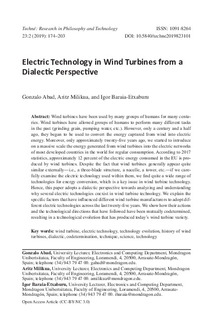| dc.rights.license | Attribution 4.0 International | * |
| dc.contributor.author | Abad, Gonzalo | |
| dc.contributor.author | Milikua, Aritz | |
| dc.contributor.author | Baraia-Etxaburu, Igor | |
| dc.date.accessioned | 2020-06-12T09:27:27Z | |
| dc.date.available | 2020-06-12T09:27:27Z | |
| dc.date.issued | 2019 | |
| dc.identifier.issn | 1091-8264 | en |
| dc.identifier.other | https://katalogoa.mondragon.edu/janium-bin/janium_login_opac.pl?find&ficha_no=152830 | en |
| dc.identifier.uri | https://hdl.handle.net/20.500.11984/1686 | |
| dc.description.abstract | Wind turbines have been used by many groups of humans for many centu-ries. Wind turbines have allowed groups of humans to perform many different tasks in the past (grinding grain, pumping water, etc.). However, only a century and a half ago, they began to be used to convert the energy captured from wind into electric energy. Moreover, only approximately twenty-five years ago, we started to introduce on a massive scale the energy generated from wind turbines into the electric networks of most developed countries in the world for regular consumption. According to 2017 statistics, approximately 12 percent of the electric energy consumed in the EU is pro-duced by wind turbines. Despite the fact that wind turbines generally appear quite similar externally—i.e., a three-blade structure, a nacelle, a tower, etc.—if we care-fully examine the electric technology used within them, we find quite a wide range of technologies for energy conversion, which is a key issue in wind turbine technology. Hence, this paper adopts a dialectic perspective towards analyzing and understanding why several electric technologies coexist in wind turbine technology. We explain the specific factors that have influenced different wind turbine manufacturers to adopt dif-ferent electric technologies across the last twenty-five years. We show how their actions and the technological directions that have followed have been mutually codetermined, resulting in a technological evolution that has produced today’s wind turbine variety. | en |
| dc.language.iso | eng | en |
| dc.publisher | Philosophy Documentation Center | en |
| dc.rights | © The Authors | en |
| dc.rights.uri | http://creativecommons.org/licenses/by/4.0/ | * |
| dc.subject | wind turbine | en |
| dc.subject | electric technology | en |
| dc.subject | technology evolution | en |
| dc.subject | history of wind turbines | en |
| dc.subject | dialectic | en |
| dc.subject | codetermination | en |
| dc.subject | technique | en |
| dc.subject | science | en |
| dc.subject | technology | en |
| dc.title | Electric Technology in Wind Turbines from a Dialectic Perspective | en |
| dcterms.accessRights | http://purl.org/coar/access_right/c_abf2 | en |
| dcterms.source | Techné: Research in Philosophy and Technology | en |
| local.contributor.group | Sistemas electrónicos de potencia aplicados al control de la energía eléctrica | es |
| local.description.peerreviewed | true | en |
| local.description.publicationfirstpage | 174 | en |
| local.description.publicationlastpage | 203 | en |
| local.identifier.doi | http://dx.doi.org/10.5840/techne2019823101 | en |
| local.rights.publicationfee | APC | en |
| local.rights.publicationfeeamount | 1000 USD | en |
| local.source.details | Vol. 23. N. 2. Pp. 174-203, 2019 | eu_ES |
| oaire.format.mimetype | application/pdf | |
| oaire.file | $DSPACE\assetstore | |
| oaire.resourceType | http://purl.org/coar/resource_type/c_6501 | en |
| oaire.version | http://purl.org/coar/version/c_970fb48d4fbd8a85 | en |








